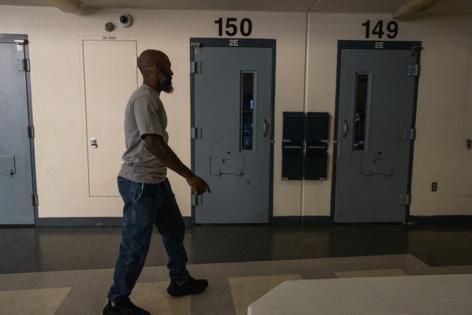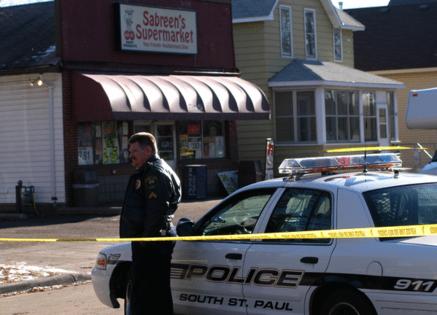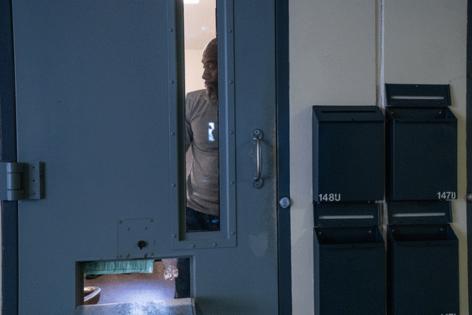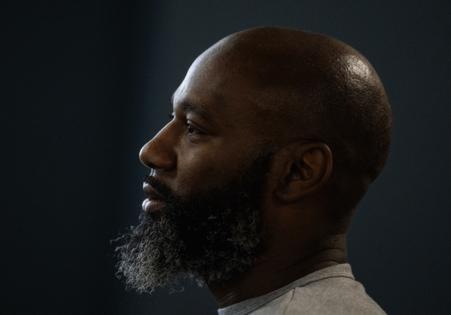Prisoner's case puts Minnesota's wrongful conviction unit under scrutiny
Published in News & Features
MINNEAPOLIS — Philip Vance has been waiting four years for the state to decide whether his murder conviction should be overturned.
The 45-year-old is serving a life sentence for the killing of a South St. Paul grocery clerk in 2002. Vance maintains he’s innocent. He points to the lack of physical evidence in the case and the fact that some witnesses who said they heard him confess have since recanted, saying the police pressured them to lie.
Vance exhausted his appeals in 2006, when the Minnesota Supreme Court upheld his conviction. But as the years passed, more people who testified against him started changing their stories.
A three-person division in Minnesota Attorney General Keith Ellison’s office could play a major role in whether Vance is released.
The Conviction Review Unit was created to review cases of prisoners claiming to be innocent, and in the past, when it recommended overturning murder convictions, people have been set free. Out of more than 1,000 people clamoring for its help, Vance’s 2021 application was strong enough for the unit to accept.
But Vance has waited years for results. The CRU has given few updates on its progress, he said, heightening his doubts that it will conclude in his favor.
The delay has left him in legal limbo.
In 2022, Vance opened a simultaneous court case for relief based on witness recantations. But those proceedings have been stalled as they wait for the CRU. So the very organization created to help those who say they were wrongly convicted is hindering the process, said Vance’s lawyer Nico Ratkowski.
“The longer we wait, the more we risk witnesses becoming unavailable,” Ratkowski said at a status hearing in October. “I struggle to see why it makes sense to wait for an indefinite amount of time for a third-party entity, that’s not the court, to do something.”
The Vance case is emblematic of both the promise and realities of the CRU, which has completed just five reviews since it started in 2021. Families of the incarcerated have grown impatient, with some suspecting it lacks the gumption to challenge powerful law enforcement interests in all but slam-dunk cases.
Police and county prosecutors have also pushed back on some of the unit’s conclusions, questioning the integrity and transparency of the entity created to check their work.
In February, the CRU informed Vance and Dakota County Attorney Kathy Keena, who prosecuted him, to expect a final report “soon.” Both sides agreed to pause Vance’s parallel court case until the CRU acts. Nine months later, no report has come.
CRU Director Carrie Sperling wouldn’t predict when her office would finish Vance’s report. But she told the judge in his relief case that it was in the final stage of review.
“We all have this in the forefront of our minds, that this is important, it needs to get out,” Sperling said.
Vance’s face was a mask of impassivity as he watched the October hearing from the Rush City prison. Bald now, with white streaks in his beard, he has spent most of his life behind bars. When the judge agreed to keep waiting for the CRU to provide its report and for the county prosecutor to respond, he said nothing, signing off with a two-fingered salute.
Three nights before Christmas 2002, two men robbed Sabreen’s Supermarket in South St. Paul. Khaled Al-Bakri, the 25-year-old clerk behind the counter, was shot twice in the back of the head.
Customers caught glimpses of the suspects. They described someone grabbing money from the cash register and someone yelling in Spanish. A group of teenagers saw two men in baggy pants and hooded sweatshirts jump into a car and zoom off.
Their faces were masked. The security camera wasn’t recording. The murder weapon was never recovered. The crime scene yielded nothing revealing the robbers’ identities.
“The state doesn’t have any actual physical evidence,” Keena told jurors during the 2004 trial. “If you’re looking for DNA to be all over a piece of clothing that Mr. Vance might have been wearing that night, we don’t have it.”
Yet the state was sure of Vance’s guilt, Keena said, because, “by God, we got a bunch of people that he told,” indicating about a dozen people were prepared to testify against Vance.
One of the first witnesses was Colleen McManus, night manager at a downtown St. Paul bar. She said Vance and his friend Dominic Johnson were drinking there on the night of the murder, and McManus testified the two men appeared “real skittery.” When she asked Vance what was wrong, he implied having made a mistake and gestured with his hand in the shape of a gun, she said at trial.
One of McManus’ brothers was a St. Paul police officer assigned to the Minnesota Gang Strike Force. She said she called him right away, and the investigation against Vance and Johnson took off.
Another confidential informant, a bartender at a different bar, wore a wire to purchase a gun from Vance. It didn’t turn out to be the murder weapon, but she testified that Vance bragged about shooting a man five times in the back on the south side. Several police officers were listening in, and they said they heard Vance confess.
However, no recording was ever produced because Andrew Shoemaker of the Minnesota Gang Strike Task Force said the background noise was so loud “that it was difficult at points to hear the conversation.”
Asked if he could make out Vance’s confession, Shoemaker said, “At that point, my signal was clear and I would very clearly hear.” Shoemaker could not be reached for comment, and according to the South St. Paul Police Department, there was no one left who is familiar with the case.
The prosecution produced other witnesses who painted a portrait of the young men as reckless barflies with street names and no jobs, looking to score easy money for their kids’ Christmas presents.
Defense attorneys called no one — including Vance — to refute their claims. He was sentenced to life in prison.
The CRU launched with lofty expectations when Ellison announced that it would be one of the first efforts by a state government to investigate claims of wrongful conviction. But skeletal staffing and a staggering wave of applications have slowed results.
The unit operates mostly in secret, frustrating law enforcement and families of the incarcerated. There is no public disclosure on the cases it works on or how long a review has taken. Reporters must file public records requests to obtain the agendas and minutes of its public advisory board meetings. A county sheriff who had questions about a review involving his department had to do the same for the board’s contact information.
Aitkin County Sheriff Dan Guida recently published a commentary questioning the CRU’s conclusion that Brian Pippitt was wrongfully convicted of murdering Evelyn Malin, for which he served 26 years. “If the CRU’s conclusions are to carry weight, its process must withstand scrutiny,” Guida wrote.
Since its inception, the unit has recommended vacating the murder convictions of three men: Pippett, Thomas Rhodes and Edgar Barrientos-Quintana. The identities of two others have not been publicized. It’s safe to assume, Sperling told the Minnesota Star Tribune, that the recommendations in those cases weren’t favorable to applicants.
Even as a recent audit praised the CRU’s output compared to other states, the pace of its work has frustrated family members.
Marvina Haynes, the sister of exoneree Marvin Haynes, said they canceled his application because it took too long. A judge eventually freed Haynes through a court process, finding he was wrongfully convicted.
The CRU is expected to issue a report on Vance next, Sperling said at a recent hearing.
Sperling declined to discuss the specifics of Vance’s case, but in an interview spoke generally about some factors that would influence the CRU’s decision on whether to conduct a review.
For one, the CRU’s charter describes how the involvement of systemic bad actors, such as discredited medical examiners and officers, might warrant a second look.
Vance’s petition notes that several Minnesota Gang Strike Force officers who worked his case were publicly disciplined for professional misconduct.
The Minnesota Gang Strike Force, which later became the Metro Gang Strike Force, was permanently dissolved in 2009 after a review panel revealed agents took home confiscated items such as TVs and jewelry, and stole cash from people they stopped in the street. Narcotics that were supposed to be entered into evidence went missing.
Leslie Redmond, ex-Minneapolis NAACP president and a former CRU advisory board member, said she pushed for a closer look at convictions during the disgraced strike forces’ heyday. She supports Vance’s release.
“My theory is because of the population of people that [the Gang Strike Force] was impacting wasn’t one that was protected, people weren’t looking at it,” Redmond said.
But the bulk of Vance’s petition is anchored on the witnesses shifting their testimony against him.
In notarized declarations, a man who said he overheard Vance and Johnson at the bar on the night of the murder now says he was never there, and that police fed him what to say in return for lesser criminal charges.
Another jailhouse informant said he fabricated his testimony for a lighter sentence.
The bartender who helped officers conduct the undercover wire operation signed an affidavit saying she lied to avoid her own legal trouble.
And the aunt of a woman Vance was dating at the time recanted having heard him brag about the murder during a party at her house. She said police kept showing up at her bus stop, leading her to believe something bad would happen to her child’s father in jail if she didn’t testify.
When the Star Tribune asked Sperling if she had any qualms about witnesses changing their stories, she said judges aren’t always convinced of witness backtracking. A judge could question if the individual was ever credible, considering they testified in court and later told a notary under oath that they had lied. It’s critical to examine what led a witness to recant, she said.
“It’s been shown that you can contaminate people’s memory, where you kind of replace or put in a memory that now they have,” Sperling said.
Vance’s investigation has taken a long time, she said, because if the CRU’s work isn’t thorough, the nascent program can lose buy-in from law enforcement that provides access to original case files.
McManus — the former bar manager who served as a confidential informant for her police officer brother — still believes Vance is guilty.
“At different points, I wanted to reach out and just tell him how badly I feel about the whole thing,” McManus said in an interview. “Not my part of it. I don’t regret that at all, you know, I stand by I did the right thing at the right time.”
The Dakota County Attorney’s Office said in court that it won’t comment on Vance’s case until the CRU releases its findings. A spokesperson told the Star Tribune the office has fully cooperated with the unit’s independent investigation.
The family of the victim, Al-Bakri, did not respond to an interview request.
During an interview at Rush City in September, Vance spoke in a calm, deliberative way as he reminisced about past mistakes, including his decision to stay silent during his trial.
His trial lawyers advised him against testifying, he said, because the state lacked proof to convict. He now understands that courts don’t require any physical evidence to find someone guilty of murder, and that, in lieu of anyone pushing back on extensive testimony that he told many people about killing Al-Bakri, the jury had no reason to believe he hadn’t.
Decades ago, Vance hoped authorities would eventually determine his innocence. Now, he says he’s worried his CRU review has dragged on because it’s politically sensitive.
“The reason I’m here is because of what the police did,” Vance said he insisted to Sperling when she interviewed him in March 2024. That led to a back-and-forth that left him feeling unsettled.
He thought that was the last phase of the CRU’s investigation.
_____
©2025 The Minnesota Star Tribune. Visit at startribune.com. Distributed by Tribune Content Agency, LLC.














Comments